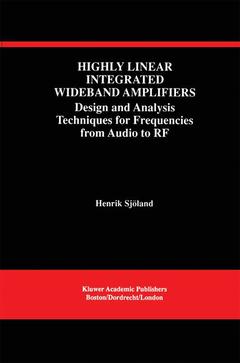Description
Highly Linear Integrated Wideband Amplifiers, Softcover reprint of the original 1st ed. 1999
Design and Analysis Techniques for Frequencies from Audio to RF
The Springer International Series in Engineering and Computer Science Series, Vol. 490
Author: Sjöland Henrik
Language: English
Keywords
Publication date: 10-2012
163 p. · 15.5x23.5 cm · Paperback
163 p. · 15.5x23.5 cm · Paperback
Description
/li>Contents
/li>
Highly Linear Integrated Wideband Amplifiers: Design and AnalysisTechniques for Frequencies from Audio to RF deals with the complicated issues involved in the design of high-linearity integrated wideband amplifiers for different operating frequencies. The book demonstrates these principles using a number of high-performance designs. New topologies for high linearity are presented, as well as a novel method for estimating the intermodulation distortion of a wideband signal.
One of the most exciting results presented is an enhanced feedback configuration called feedback boosting that is capable of very low distortion. Also important is a statistical method for relating the intermodulation distortion of a wideband signal to the total harmonic distortion (THD) of a single tone. The THD, as opposed to the intermodulation distortion of the wideband signal, is easy to measure and use as a design parameter.
Three different applications where high linearity is needed are identified, namely audio power amplifiers, wideband IF amplifiers and RF power amplifiers. For these applications high-performance integrated amplifier designs using novel topologies are presented together with measurement results. The audio amplifiers are built in CMOS and are capable of driving 8Omega loudspeaker loads directly without using any external components. One of the designs can operate on a supply voltage down to 1.5V. Both bipolar and CMOS wideband IF amplifiers are built; they are fully differential and have linearity from DC to 20 MHz. Finally, an RF power amplifier is built in CMOS, without using inductors, in order to investigate what performance can be achieved without them.
Highly Linear Integrated Wideband Amplifiers: Design and AnalysisTechniques for Frequencies from Audio to RF is an excellent reference for researchers and designers of integrated amplifiers, and may be used as a text for advanced courses on the topic.
One of the most exciting results presented is an enhanced feedback configuration called feedback boosting that is capable of very low distortion. Also important is a statistical method for relating the intermodulation distortion of a wideband signal to the total harmonic distortion (THD) of a single tone. The THD, as opposed to the intermodulation distortion of the wideband signal, is easy to measure and use as a design parameter.
Three different applications where high linearity is needed are identified, namely audio power amplifiers, wideband IF amplifiers and RF power amplifiers. For these applications high-performance integrated amplifier designs using novel topologies are presented together with measurement results. The audio amplifiers are built in CMOS and are capable of driving 8Omega loudspeaker loads directly without using any external components. One of the designs can operate on a supply voltage down to 1.5V. Both bipolar and CMOS wideband IF amplifiers are built; they are fully differential and have linearity from DC to 20 MHz. Finally, an RF power amplifier is built in CMOS, without using inductors, in order to investigate what performance can be achieved without them.
Highly Linear Integrated Wideband Amplifiers: Design and AnalysisTechniques for Frequencies from Audio to RF is an excellent reference for researchers and designers of integrated amplifiers, and may be used as a text for advanced courses on the topic.
1 Introduction.- 1.1 Wideband IF Amplifiers.- 1.2 RF Power Amplifiers.- 1.3 Audio Power Amplifiers.- 1.4 References.- 2 Integrated Transistors and Amplifiers.- 2.1 Integrated Analog Electronics in Short.- 2.2 Amplifiers in General.- 2.3 Transistors.- 2.4 References.- 3 Amplifier Linearization Techniques.- 3.1 Negative Feedback.- 3.2 Feed-Forward.- 3.3 Predistortion.- 3.4 Cancellation.- 3.5 References.- 4 Advanced Feedback Techniques.- 4.1 The Asymptotic-Gain Model.- 4.2 Stability.- 4.3 Phase-Compensation Techniques.- 4.4 Feedback Boosting.- 4.5 References.- 5 Output Stages.- 5.1 Classes of Operation.- 5.2 Low Voltage Output Stages.- 5.3 References.- 6 Analysis and Measurement of Distortion.- 6.1 Computer Simulation of Distortion.- 6.2 Distortion Measurement.- 6.3 Intermodulation Distortion related to THD.- 6.4 References.- 7 Audio Power Amplifiers.- 7.1 Requirements of Audio Power Amplifiers.- 7.2 Class of Operation.- 7.3 CMOS vs. Bipolar.- 7.4 Two CMOS Class AB Designs.- 7.5 References.- 8 Wideband IF Amplifiers.- 8.1 Performance Requirements.- 8.2 The Topology.- 8.3 Output Stages.- 8.4 Input Stages.- 8.5 Middle Stage.- 8.6 Common-Mode Feedback.- 8.7 Simulations and Measurements.- 8.8 Chip Photos.- 8.9 References.- 9 Inductorless RF CMOS Power Amplifiers.- 9.1 Requirements on RF Power Amplifiers.- 9.2 CMOS RF Power Amplifiers using Inductors.- 9.3 An Inductorless CMOS RF Power Amplifier.- 9.4 References.- 10 Layout Aspects.- 10.1 Passive Devices.- 10.2 Active Devices.- 10.3 References.
© 2024 LAVOISIER S.A.S.




